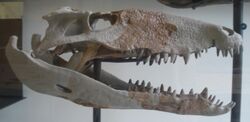Biology:Metasuchia
| Metasuchians | |
|---|---|

| |
| Skull of Sebecus icaeorhinus | |
| Scientific classification | |
| Missing taxonomy template (fix): | Archosauria/Reptilia |
| Clade: | Pseudosuchia |
| Clade: | Crocodylomorpha |
| Clade: | Crocodyliformes |
| Clade: | Mesoeucrocodylia |
| Clade: | Metasuchia Benton and Clark, 1988 |
| Clades | |
Metasuchia is a major clade within the superorder Crocodylomorpha. It is split into two main groups, Ziphosuchia and Neosuchia.[1] Notosuchia is an extinct group that contains primarily small-bodied Cretaceous taxa with heterodont dentition. Neosuchia includes the extant crocodylians and basal taxa, such as peirosaurids and pholidosaurids. It is phylogenetically defined by Sereno et al. (2001) as a clade containing Notosuchus terrestris, Crocodylus niloticus, and all descendants of their common ancestor.[2]
Phylogenetics
| Metasuchia |
| |||||||||||||||||||||||||||||||||||||||||||||
The phylogeny of basal metasuchians has experienced many revisions in recent years.[1] The phylogeny of notosuchians has been particularly revised, with the construction of Sebecia by Larsson and Sues (2007) to include peirosaurids in the clade.[3] Previously, peirosaurids were placed outside Notosuchia. Larsson and Sues (2007) also suggested that Sebecosuchia (containing the families Baurusuchidae and Sebecidae) was polyphyletic, as Baurusuchus was placed outside Sebecia, which itself was placed outside Notosuchia. However, more recent phylogenetic studies have placed Baurusuchus within Notosuchia once again, although it is still not considered to be a sebecosuchian.[1]
In 2012, a phylogenetic study was done to produce supertrees of Crocodyliformes, including 184 species.[4] The most parsimonious trees were highly resolved, meaning the phylogenetic relationships found in the analysis were highly likely. As such, below is the consensus tree from the study, focusing on the Metasuchian branch of the tree.
| Metasuchia |
| |||||||||||||||||||||||||||||||||||||||||||||||||||||||||||||||||||||||||||||||||||||||||||||||||||||||||||||||||||||||||||||||||||||||||||||||||||||||||||||||||||||||||||||||||||||||||||||||||||||||||||||||||||||||||||||||||||||||
References
- ↑ 1.0 1.1 1.2 Sereno, P. C.; Larsson, H. C. E. (2009). "Cretaceous crocodyliforms from the Sahara". ZooKeys (28): 1–143. doi:10.3897/zookeys.28.325.
- ↑ Sereno, P. C.; Larsson, H. C. E.; Sidor, C. A.; Gado, B. (2001). "The giant crocodyliform Sarcosuchus from the Cretaceous of Africa". Science 294 (5546): 1516–1519. doi:10.1126/science.1066521. PMID 11679634. Bibcode: 2001Sci...294.1516S. http://doc.rero.ch/record/16412/files/PAL_E3596.pdf.
- ↑ Larsson, H. C. E.; Sues, H.-D. (2007). "Cranial osteology and phylogenetic relationships of Hamadasuchus rebouli (Crocodyliformes: Mesoeucrocodylia) from the Cretaceous of Morocco". Zoological Journal of the Linnean Society 149 (4): 533–567. doi:10.1111/j.1096-3642.2007.00271.x.
- ↑ Bronzati, M.; Montefeltro, F. C.; Langer, M. C. (2012). "A species-level supertree of Crocodyliformes". Historical Biology 24 (6): 598–606. doi:10.1080/08912963.2012.662680.
External links
- Metasuchia in the Paleobiology Database
Wikidata ☰ Q3307307 entry
 |

